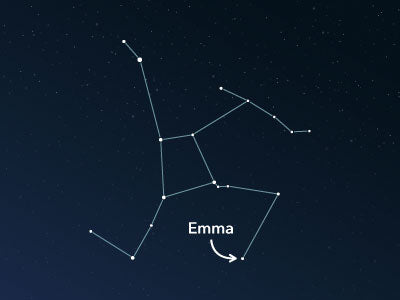The constellation Hercules
Características
- Nombre latino
- Hercules
- Hemisferio
- Hemisferio norte
- Visibilidad
- March - September
- Área
- 1225 deg²
- Estrella más brillante
- Kornephoros (HIP number 80816)
- Especialidades
- Globular clusters, planetary nebula

Hercules, a symbolization of the famous hero Heracles in Greek mythology, is one of the 48 constellations the Greek-Roman astronomer Claudius Ptolemy described in ancient times. Some exciting deep-sky objects are located in its area.
Hemisphere, visibility, and area
The constellation lies in the northern sky and is visible between latitudes 90° N and 38° S. This means it can be observed from the entire northern hemisphere. South of the equator, it is visible up to regions such as Melbourne in Australia.
In the northern parallels, it can be best seen from March to September. From the southern hemisphere, the best view of the constellation is during June to September.
Hercules is a very large constellation. It stretches over approximately 1,225 square degrees of the night sky, making it the fifth-largest constellation.
However, it is not particularly conspicuous as only three stars are brighter than the third magnitude. The brightest of them is the star Kornephoros (Latin: β Herculis, Beta Herculis). It is a binary star system lying around 140 light-years from earth. Its apparent magnitude is about 2.77.
Hercules borders nine other constellations, which can help locate it in the night sky. The most well-known bordering constellation is Boötes, which is located to the east. Other direct neighbors include Draco, Corona Borealis, Serpens (Caput), and Ophiuchus. Additionally, Aquila, Vulpecula, Sagitta, and Lyra also border the constellation.
Specialties in the constellation
To the northeast of the star Kornephoros is the planetary nebula NGC 6210. At first, it appears as a faintly shining star, but in a telescope, a greenish-blue shimmering disk can be seen. NGC 6210 is approximately 3,000 light-years away.

In addition to the planetary nebula, there are also some interesting globular clusters.
The most impressive one is M13 (Messier 13), named after the French astronomer Charles Messier. M13 consists of about 300,000 stars, and its distance from earth is estimated to be 25,000 light-years. While it is only perceived as a hazy patch in a prism binocular, it can already be resolved into numerous individual stars in a telescope. M13 can be seen about midway between the stars η Herculis (Eta Herculis) and ζ Herculis (Zeta Herculis).
Another globular cluster is M92 (Messier 92), a smaller star cluster lying approximately 30,000 light-years away. M92 is located north of the star π Herculis (Pi Herculis).
Mythology
The constellation Hercules was already mentioned by Ptolemy in ancient times. Hercules' epithet "Engonasin" ("the Kneeling One") comes from the legend that he once knelt and bled over a defeated dragon after a battle.
However, Hercules is not the only mythical figure associated with the constellation. Prometheus, Orpheus, and Theseus were also recognized in it, but the symbolism of Hercules ultimately prevailed.
The myth of the Greek hero Heracles, son of Zeus and the wise Alcmene, is very complex and tragic.
Hera, Zeus' wife, once again embittered by her husband's infidelity, tried to kill his innocent baby Heracles by placing two venomous snakes in his cradle. The infant Heracles, who possessed boundless strength, was able to defeat the snakes.
Zeus then decided to protect his son with a special form of deathlessness. He managed to place the baby at Hera's breast during a nap and gave him immortality with her divine milk.
Hera had always sworn to make Heracles' life unbearable. He eventually grew up under the hatred of his mother-in-law, which drove him to madness. This madness later led to Heracles killing his own children.
Satisfied with the events, Hera finally took the madness away from Heracles, who now became aware of his actions. To free himself from his guilt, Heracles visited the Delphi oracle. The oracle imposed on him twelve years of service to King Eurystheus.
Eurystheus, a close friend of Hera's, gave Heracles 12 seemingly impossible tasks, including the slaying of the Nemean lion and the Hydra of Lerna. To everyone's surprise, Heracles managed to accomplish the tasks.
After the expiration of his service, he returned to his wife, who could not forgive him for the murder of their children. So, Heracles wandered alone through the world and continued to perform heroic deeds until he fell in love with and married the young Deianira.
They met the centaur Nessus on a journey, who tried to violate Heracles' beautiful wife. Heracles killed Nessus with a poisoned arrow. Before he died, Nessus managed to tell Deianira something, which later turned out to be a lie. He claimed that his blood would work as a love potion if she ever had doubts about her husband's affection.
She followed his advice, kept some blood, and gave it to her husband to drink several months later. Heracles suffered excruciating pain due to the poisoned blood. When he could no longer bear it, Heracles burned himself alive. Zeus took his soul in mourning and placed him in the sky.
PublicadoLeer más artículos interesantes

An overview of all 88 constellations
Learn more about all 88 constellations and read interesting information about the mythology, visibility, and features.

Planetario App
¡Descubre el cielo nocturno con nuestra aplicación de planetario!
Disponible para iOS y Android.

Nombrar una estrella en una constelación
Name a star in a constellation and create something that lasts for eternity.